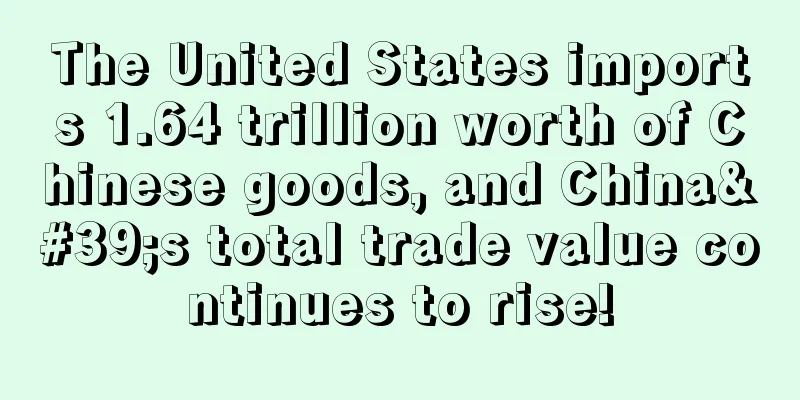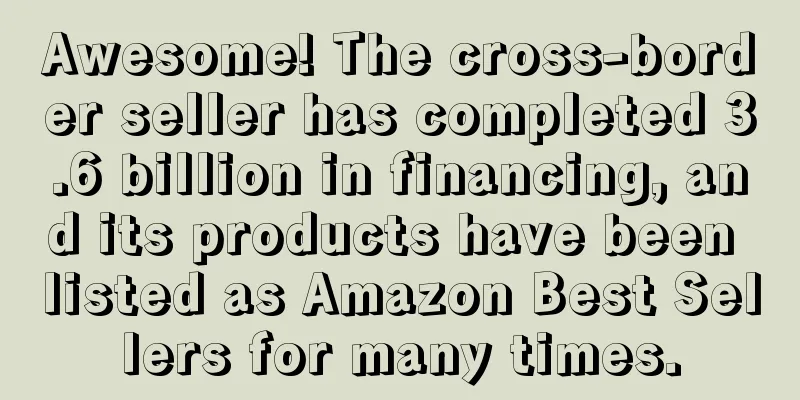Sellers earn 2.2 billion in 6 months, this market is ready to go again

|
Can the European market make another push?
After the escalation of the conflict between Russia and Ukraine, the orders of many cross-border e-commerce sellers were hit. "The sales of my store have been almost cut in half," complained one seller. Coupled with the impact of policies such as VAT, sellers have become more cautious about entering the European market in recent years. However, times have changed. With Trump's victory in the US election, the European e-commerce market is expected to pick up in the short term.
In the global e-commerce market, competition in the US market has become fierce, showing an excessive involutionary trend, while the Southeast Asian market has obvious limitations in profit margins due to generally low average customer prices. In contrast, European residents have a higher overall income level, strong spending power, and the e-commerce penetration rate is also on a continuous upward trend.
Based on these significant advantages, Europe has always been a key market for many leading cross-border e-commerce companies. Take Zhiou Technology as an example, more than 60% of its operating income comes from the European market.
In terms of platforms, TEMU and SHEIN have also increased their presence in Europe in recent years. Overall, China's cross-border e-commerce platforms are sweeping Europe, and TEMU, SHEIN and AliExpress are at the top, especially AliExpress, which ranks second only to Amazon.
However, nowadays, both sellers and platforms are more focused on Western Europe, such as the UK, Germany, France and other economically developed countries with a strong e-commerce foundation, when planning the European market. However, they rarely set foot in the Southeast European market. But in fact, the e-commerce market here has been rising rapidly in recent years, waiting for cross-border players to deepen their presence.
Trump is about to take office. Will this be good for the European market?
European countries have highly developed economies and residents' income levels rank among the highest in the world, which gives them strong spending power. This economic advantage and spending power make the European market a key target market for cross-border e-commerce sellers, second only to the US market. In recent years, many top sellers have been increasing their presence here.
For example, Anker Innovations, Europe is its second largest market, contributing 2.052 billion yuan in revenue in the first half of this year. From 2021 to the first half of 2024, the European market will bring it a total revenue of nearly 11.2 billion yuan, showing a good trend of increasing year by year.
For Savitech, Europe is also its second largest market, contributing 289 million yuan in revenue in the first half of 2024. In a previous conference call, Savitech pointed out that the consumption level in Europe is relatively high, which is more suitable for the company to carry out branding business. At the same time, the Amazon platform is also helping high-quality sellers to develop their European business, and gradually increased its investment in the European region in 2024. It shows that it is full of confidence in the future development prospects of the European market and has high expectations.
Among many sellers, Zhiou Technology is particularly dependent on the European market. Unlike other sellers, Europe is the main source of revenue for Zhiou Technology, accounting for more than 62% of total revenue in the first half of 2024, totaling 2.279 billion yuan, which is nearly 1.7 times the second largest revenue market (North America).
However, in the eyes of many sellers, the European market is more of a "playground" for big sellers, where only they can operate with ease, while small sellers have a hard time in this market. Especially in recent years, unfavorable factors such as inflation and the conflict between Russia and Ukraine have intertwined, and the complexity and cruelty of the market have further intensified, which makes small sellers have many concerns before making arrangements.
"Although there is less competition in the European site compared to the US site, the selling prices in this market are not high, and there is basically no profit after adding VAT and import taxes," said a seller helplessly.
However, with Trump winning the US presidential election, the European market needs sellers to take a fresh look.
On February 24, 2022, the conflict between Russia and Ukraine escalated abruptly. As of November 22, 2024, the conflict has lasted for more than 1,000 days. The chain reactions it triggered have profoundly affected Europe. For example, the problem of inflation is becoming more and more serious, and consumers have no choice but to adjust their consumption structure, putting the protection of basic living needs first and cutting spending on non-essentials and luxury goods. At the same time, the uncertainty of the conflict makes consumers worry about the economic situation and their own financial situation, and consumer confidence is reduced.
Trump has always stated that he will quickly end the Russia-Ukraine conflict after taking office. According to the schedule, Trump will take office on January 20, 2025. If he can put an end to the Russia-Ukraine conflict after taking office, the European market will surely pick up.
Moreover, because the UK is unlikely to be the focus of Trump's trade tariff plan, Bank of America recently predicted that the pound is expected to rise in 2025. For Chinese cross-border e-commerce sellers, the strengthening of the pound has two main effects:
On the one hand, the appreciation of the pound gives British consumers more purchasing power, which will give them a wealth effect and make them feel richer. Driven by this mentality, their desire to consume will be greatly stimulated, and they will be more willing to open their wallets to "buy, buy, buy".
On the other hand, the strengthening of the pound means that the same amount of pounds can be exchanged for more RMB. When Chinese cross-border e-commerce companies sell goods to the UK and earn pound income, they can get more money when they convert it into RMB, which directly increases the company's profits.
Chinese platforms are showing their strength, taking three seats in the TOP 10 list
According to TradingPlatforms, the penetration rate of e-commerce in Europe will reach 67.1% in 2025. Under this trend, not only sellers but also domestic cross-border e-commerce platforms regard Europe as a strategic location. Moreover, many platforms have already achieved significant interim results.
Some time ago, European cross-border e-commerce research organization CBCommerce announced the latest list of "Top 100 Cross-border E-commerce Platforms in Europe". Three of China's "Four Little Dragons Going Global", AliExpress, TEMU and SHEIN, successfully ranked among the top ten.
Among these platforms, AliExpress performed the best, taking second place, closely following the industry giant Amazon. TEMU, which has risen rapidly since its launch in 2022, ranked fifth, and SHEIN ranked eighth.
It is also worth noting that compared with a year ago, TEMU jumped 4 places, while SHEIN successfully entered the top 10. This fully demonstrates the strong development momentum and huge potential of Chinese cross-border e-commerce platforms in the European market.
Judging from the business data, SHEIN's sales in Europe have increased significantly. Last year, its sales in Europe were 7.684 billion euros (8.36 billion U.S. dollars), an increase of 68% compared with the previous year. In addition to the significant increase in sales, profitability has also been improved. Its after-tax profit jumped to 99.5 million euros in 2023, nearly doubling from 45.8 million euros in 2022. At the same time, gross profit also increased significantly from 172 million euros in 2022 to 314 million euros in 2023.
Although TEMU’s revenue data in Europe has not been disclosed, its ranking three positions ahead of SHEIN means that its revenue will not be bad.
In fact, Chinese cross-border e-commerce platforms have already begun to show their strength in Europe several years ago. In 2021, in the "Top 100 Cross-border E-commerce Platforms in Europe" released by CBCommerce, AliExpress and WISH from China were already among the top ten, ranking second and seventh respectively. Although WISH has now fallen out of the top ten, TEMU and SHEIN have quickly filled the gap and are shaking up the European e-commerce market with even better performance.
In the European market, the layout of Chinese cross-border e-commerce platforms is expanding day by day, and the business scope of Alibaba Group is particularly extensive. Many platforms under the group, including AliExpress , Lazada, Trendyol, Miravia and Alibaba International Station, have already started business in Europe, forming a diversified cross-border e-commerce network.
Unlike Alibaba, ByteDance entered the market through social e-commerce. In 2021, TikTok Shop's first site in Europe, the UK site, was officially launched, kicking off its e-commerce journey in Europe. In July this year, new progress was made: the Spanish and Irish sites entered the internal testing phase. Sellers who have received targeted invitations have already started selling in these two countries.
Judging from user data, TikTok has demonstrated a strong influence in the EU, with 150.5 million monthly active users. This massive user base has undoubtedly laid a very strong potential consumer group foundation for TikTok Shop's business in Europe.
Judging from the current market situation, Europe has become an emerging strategic location that many domestic cross-border e-commerce platforms have high hopes for, especially the emerging platform TEMU, which has even shifted its development focus from the United States to here.
Morgan Stanley analysts pointed out that the contribution of the US market to Temu's GMV is expected to drop from more than 50% in 2023 to 33% in 2024, and further to 30% in 2030. At the same time, the European market is expected to become Temu's largest source of GMV in 2024, accounting for 37%.
According to forecasts, TEMU's GMV will grow from $19 billion in 2023 to $53 billion in 2024. It can be estimated that in 2024, TEMU's revenue in Europe will reach $19.61 billion.
It is hard not to be amazed at the results achieved in less than two years after entering the market ( launched in the UK in April 2023).
Currently, TEMU has rapidly expanded to 27 EU countries including Germany, France, Italy, the Netherlands, and Spain. As of September 2024, Temu's monthly active users in the EU have reached 92 million. As early as May this year, its monthly active users in Europe have exceeded Amazon and AliExpress, 38% and 82% higher respectively.
According to relevant data, TEMU ranks among the top 5 in terms of traffic share in major European e-commerce markets such as France, the United Kingdom and Germany.
Southeast Europe is rising strongly, another new cross-border blue ocean
The latest report from Mordor Intelligence shows that the European e-commerce market is estimated to reach US$647.34 billion in 2024 and is expected to further climb to US$951.16 billion by 2029.
Based on natural geography, Europe is divided into Western Europe, Eastern Europe, Southern Europe, Northern Europe and Central Europe. Due to the inconsistent pace of economic development, the e-commerce market conditions in various parts of Europe are also different.
Western Europe has always been a dominant player in the European e-commerce landscape. According to the European E-commerce Report 2024 jointly released by Ecommerce Europe and EuroCommerce, the e-commerce market size in Western Europe will reach 596 billion euros in 2023.
However, with the influx of many cross-border e-commerce sellers and cross-border e-commerce platforms, it has become very "crowded". And its e-commerce market size has shown signs of decline (down 1% in 2023). In contrast, Southern Europe and Eastern Europe have shown strong growth momentum. In 2023, the e-commerce market size increased by 14% and 15% respectively.
Southeast Europe includes more than a dozen countries. Overall, the e-commerce markets in Romania, Hungary and Bulgaria are developing particularly rapidly.
The following is an overview of its e-commerce market :
Romania has a total population of 19.05 million, a per capita GDP of US$18,400 in 2023, and an Internet penetration rate of 74%.
According to ecommerce DB, the country's e-commerce market revenue will grow at an annual rate of 13.28% from 2023 to 2027, and the market size is expected to reach 8.759 billion euros in 2027.
In 2024, driven by the growth of Internet penetration, young population and indigenous income, the sales of Romania's e-commerce market are expected to reach 11.5 billion euros, an increase of about 16% year-on-year.
Most Romanian consumers prefer branded consumption and believe that brand is one of the important decision-making factors in purchasing goods. They also pay attention to the cost-effectiveness of products. According to the Aqurate Map report, in 2023, the most popular categories in the Romanian e-commerce market will be electronic products, followed by fashion products, beauty products, household products, and baby and pet products.
Hungary has a total population of 9.58 million, a per capita GDP of US$22,100 in 2023, and an Internet penetration rate of approximately 88%.
In 2019, the value of its e-commerce business was 781 billion Hungarian forints (about 2.2 billion euros), and is expected to exceed 4.9 billion euros by 2024, with a clear growth trend. According to Statista, the revenue of the Hungarian e-commerce market is expected to reach 2.395 billion US dollars in 2024, with a user penetration rate of 37%. By 2029, the e-commerce penetration rate in this market will further expand to 45.1%.
Hungarian consumers often use cash on delivery and bank transfer as payment methods, of which cash on delivery is particularly popular, but cashless payment methods such as credit card payments in the banking system also have a high usage rate. Clothing, shoes and handbags, smartphones and accessories, toys and gifts are popular product categories purchased online by Hungarian consumers. Cross-border e-commerce express COD parcels are easy to send and cover a wide range of products. They usually provide door-to-door services, which are undertaken by professional logistics companies and support real-time tracking of packages and multilingual customer service.
Bulgaria has a total population of 6.43 million, a per capita GDP of US$15,800 in 2023, and an Internet penetration rate of approximately 72%.
In 2022, the Bulgarian e-commerce market will reach 1.64 billion euros, up 31% from 2021. According to ecommerceDB, its e-commerce sales in 2024 are expected to be 1.2507 billion US dollars, with a compound annual growth rate of 13.6% from 2024 to 2028, and the market size is expected to reach 2.0866 billion US dollars by 2028. With the further popularization of the Internet and the continuous change in consumer shopping habits, the country's e-commerce market is expected to continue to grow in the next few years.
Locals have a high demand for goods in areas such as fashion, technology and health. Fashion apparel and accessories, electronic products and smart home, health and beauty products, children's products and toys are all popular categories.
Cash on delivery is their most common payment method. In addition, most online shopping activities also support debit and credit cards, or online payment through platforms such as epay.bg, transcard and paypal. In terms of logistics, express delivery to the door and pick-up at the pickup point are common choices.
Currently, the platform active in the Southeast European market is mainly eMAG.
The platform is known as the "Taobao" of Southeast Europe and has a high brand awareness and user base in countries such as Romania, Bulgaria and Hungary. Currently, it has more than 9 million active users and more than 120 million monthly visits.
As of fiscal year 2024, eMAG's turnover in Romania, its largest market, reached 5.979 billion lei (about US$1.265 billion), an increase of 11% year-on-year, and its order volume doubled.
The rapidly growing Southeast European market is still a blue ocean for domestic overseas sellers, and eMAG is an excellent opportunity to enter this blue ocean market.
It is reported that eMAG has opened to Chinese sellers. In November last year, its first China operation center opened in Ningbo. Since then, it has begun to expand the recruitment of Chinese sellers, mainly in the categories of fashion, fast-moving consumer goods, home gardening, outdoor sports, etc.
At present, the total number of sellers on the platform is small (less than 100,000), and the number of Chinese sellers is even smaller. At a recent investment promotion conference, its global investment promotion director Alexandru said that there are currently less than 6,000 Chinese sellers on the platform. In the past 12 months, 4,990 sellers have generated sales records, accounting for 83% of the total number of Chinese sellers, and the order growth rate is as high as 117%.
From an economic perspective, according to data from the European Statistical Office, the economic prosperity index and retail confidence index of Southeast European countries have continued to lead the EU average in the past few years. In terms of population structure, compared with Western Europe, the degree of population aging in Southeast Europe is relatively low, and the proportion of young people is relatively high. Young people are more receptive to new things and are more willing to try and use e-commerce platforms for shopping. They are the main force of e-commerce consumption and provide strong consumption potential for the e-commerce market.
According to Statista, e-commerce in major markets in Southeast Europe, such as Romania, Bulgaria and Hungary, is expected to grow at a compound annual growth rate of 23% to reach 25 billion euros by 2025.
In this context, many cross-border e-commerce sellers and platforms have focused their attention on the Southeast European market. Fortunately, international giants such as Amazon and eBay mostly cover parts of the Southeast European market through sites in other major European countries, and have not yet opened sites directly in the region. Therefore, eMAG is still the only dominant player in Southeast Europe.
This is undoubtedly an excellent opportunity for cross-border e-commerce sellers and platforms that are seeking new opportunities and want to avoid fierce competition. They can plan ahead, seize market opportunities, open up a new world in the emerging e-commerce field in Southeast Europe, and achieve diversified business expansion and new growth breakthroughs. European e-commerce |
<<: Orders are worse than usual! A group of sellers are going to be in trouble on Black Friday
Recommend
Japanese department store sales fell 30% in January, Japan will extend the state of emergency!
Japan's four major department stores announce...
As the European Cup approaches, AliExpress merchants are actively preparing for the "Super Breakout Day"
Signing Beckham as global spokesperson, becoming ...
What is Snagshout
Snagshout provides Amazon sellers with product ma...
With physical stores frequently being stolen, are American online sellers going to suffer?
According to foreign media reports, "organiz...
What is ShipHero? ShipHero Review, Features
Founded in 2013, ShipHero is a New York-based e-co...
Another batch of Amazon hot products are accused of copyright infringement! Sellers, please avoid it!
Infringement has always been an unavoidable topic...
What is Kibly
Kibly is an automated email tool that helps Amazo...
What is Trendyol? Trendyol Review, Features
Founded in 2010, Trendyol is Turkey's most fa...
Holiday sales increased by 6.1%, is US holiday retail weak?
According to Digital Commerce 360, U.S. e-commerc...
Peruvian online shopping apps are popular, with 73% of buyers choosing Linio for shopping!
With the popularity of the Internet and mobile ap...
“National” cross-border e-commerce: major domestic brands collectively go overseas, ByteDance launches a cross-border export APP!
The competition in the field of cross-border e-co...
What is Jockey? Jockey Review, Features
Founded in 1876, Jockey was born and headquartered...
With global e-commerce traffic declining, can this year’s “Black Friday” and “Cyber Monday” still trigger a wave of hot sales?
Recently, Salesforce released the shopping index ...
It’s the start of the school year in Peru, and these products are the best-selling ones!
The South American country of Peru also welcomed ...
What is YOOX? YOOX Review, Features
Founded in Milan in 2000, YOOX , full name “YOOX ...









